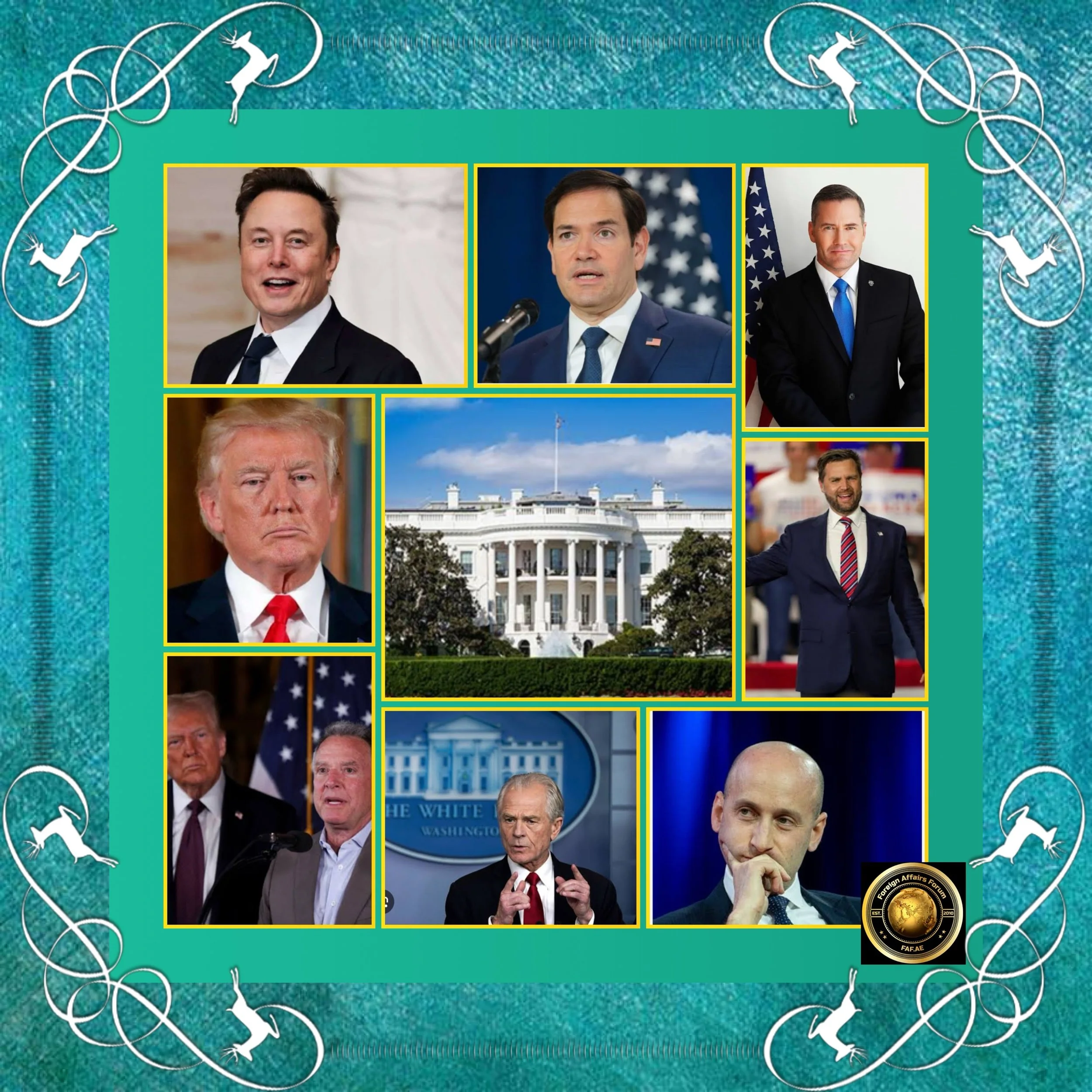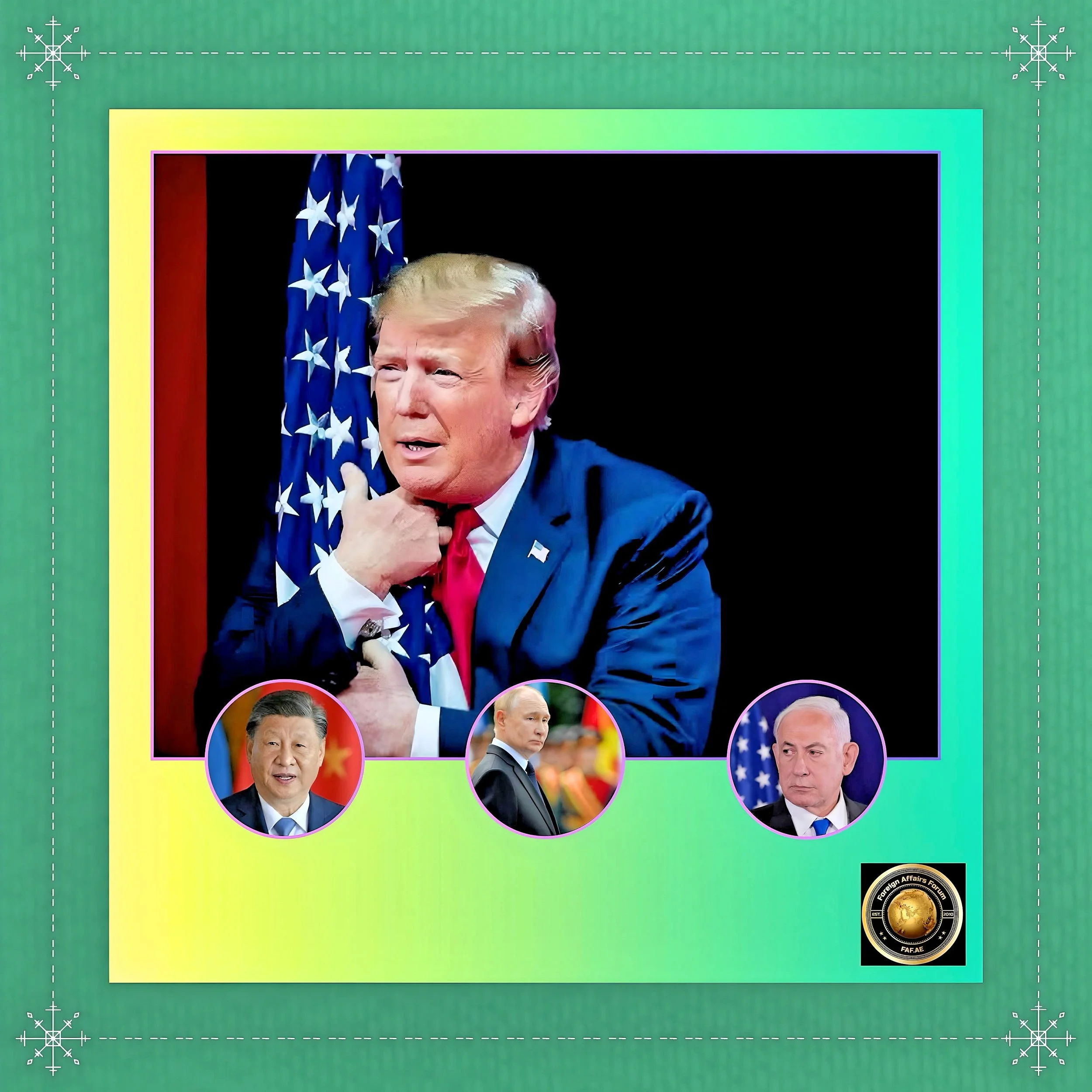The Drivers and Passengers of Trump’s Foreign Policy: First 100 Days of Trump’s Second Term
Introduction
As President Donald Trump marks his first 100 days in office during his second term, his administration has demonstrated a marked departure from conventional foreign policy approaches, characterized by chaotic, disruptive, and confrontational actions on the global stage.
This period has revealed key figures who have emerged as primary architects of Trump’s foreign policy agenda, while others have been relegated to the sidelines.
The America First Doctrine: Underlying Foreign Policy Principles
Before examining the key players, it’s essential to understand the foundational principles guiding Trump’s second-term foreign policy. The administration continues to embrace the “America First” doctrine, which has been described as containing three main pillars:
A worldview that draws the key global fault line between the United States and everyone else, where America stands apart from the international community
The conviction that the United States is being taken advantage of through unfair trade deals, free-riding allies, and open borders
A negotiating strategy of “escalate to de-escalate,” making extreme demands to throw negotiating partners off balance
This doctrine has manifested in several significant foreign policy actions during Trump’s first 100 days, including proposed peace deals with Ukraine that favor Russia, mass deportations to El Salvador, and an aggressive trade war targeting China with tariffs as high as 145 percent.
Distinguishing Features of Trump’s Second Term
Unlike his first presidency, Trump’s second term has shown less internal churn among top officials but increased assertiveness in implementing his agenda.
The administration has taken a more hardline approach to pursuing the “Return to Peace through Strength” concept, which critics sometimes describe as isolationist.
However, unlike his first term, Trump now appears less willing to be steered by advisors with differing views.
The Drivers: Key Figures Shaping Trump’s Foreign Policy
Peter Navarro: The Trade Warrior
Peter Navarro has emerged as the primary architect of Trump’s trade policy, second only to the president himself.
Unlike during Trump’s first term when Navarro was balanced by conventional economic thinkers like Steven Mnuchin and Gary Cohn, he has taken on a much more prominent role in the second administration.
His influence derives partly from his loyalty, which he proved by serving a four-month prison sentence for defying a congressional subpoena related to the January 6 committee investigation.
Navarro has been described as “combining a similar profound misunderstanding of how trade works with a love of import duties on American firms as a cure-all for things that don’t necessarily need fixing.”
However, his influence appeared to wane in early April after Trump backed away from an all-out trade war following adverse market reactions.
Stephen Witkoff: The “Real Secretary of State”
Despite his lack of diplomatic experience, real estate developer Stephen Witkoff has emerged as a central figure in Trump’s foreign policy apparatus.
He became so influential that Democratic Senator Adam Schiff described him as the “real secretary of state,” Witkoff “clearly has a far greater role in both the Middle East and Russia” than official Secretary of State Marco Rubio.
Witkoff’s portfolio has expanded to include spearheading talks on Iran’s nuclear program, with the administration seeking an agreement to prevent Iran from developing nuclear weapons.
He has offered mixed messages about whether the U.S. wants Iran to limit or completely dismantle its nuclear program, with Trump threatening military action if a deal isn’t reached.
J.D. Vance: The Attack Dog
Vice President J.D. Vance has positioned himself as Trump’s loyal foreign policy enforcer. Initially expected to echo his boss’s agenda, Vance has embraced and amplified the administration’s aggressive foreign policy stance.
His February speech at the Munich Security Conference “stunned European lawmakers” by revealing the dramatic shift in trans-Atlantic relations under the second Trump administration.
Vance further cemented his role during Ukrainian President Zelensky’s White House visit, when after sitting quietly for most of the meeting, he “butted in aggressively,” setting the stage for Trump and himself to “loudly berate their Ukrainian counterpart in an explosive and public face-off.”
Vance has also led controversial initiatives, such as an unwelcome diplomatic mission to Greenland, doubling down despite clear resistance from the island’s representatives.
Stephen Miller: The Hard-liner
Stephen Miller, who gained notoriety during Trump’s first term as the architect of controversial immigration policies, now wields even greater influence as homeland security advisor and White House deputy chief of staff for policy.
A leaked group chat from the so-called “Signalgate” scandal revealed Miller’s commanding role in administration discussions.
Miller’s influence is particularly evident in steering the administration’s mass deportation efforts, which have included striking deals with Latin American nations like El Salvador to accept deportees into their prison systems without due process.
The Struggling Passengers: Officials With Diminishing Influence
Mike Waltz: The Conflicted National Security Advisor
National Security Advisor Mike Waltz appears to be struggling with his role, as reports indicate his views frequently diverge from the president’s.
His influence has been undermined by figures like social media personality Laura Loomer, who reportedly convinced Trump to dismiss several of Waltz’s National Security Council staff for purported disloyalty and “neoconservative sympathies.”
Marco Rubio: The Overshadowed Secretary of State
While Marco Rubio holds the official title of Secretary of State, his influence appears significantly diminished compared to unofficial actors like Stephen Witkoff.
Senator Schiff’s characterization of Witkoff as the “real secretary of state” suggests Rubio has been sidelined in major foreign policy decisions regarding the Middle East and Russia.
Elon Musk: The Waning Influence
Elon Musk initially leveraged his significant campaign donations into an influential role in Trump’s administration. He participated in calls with foreign leaders, attended high-level Pentagon meetings, and met directly with Indian Prime Minister Narendra Modi.
However, Musk’s influence over Washington’s global relationships has reportedly declined in recent weeks as he has shifted focus to more domestic priorities through his unofficial Department of Government Efficiency (DOGE) and maintaining a stream of pro-Trump posts on his social media platform, X.
His role as a “special government employee” has a 130-day time limit that expires in about a month, and there is uncertainty about whether he’ll remain afterward.
Key Foreign Policy Actions in the First 100 Days
Russian-Ukrainian War Approach
The Trump administration has fundamentally altered U.S. policy toward Ukraine.
On February 12, 2025, Defense Secretary Pete Hegseth declared that returning to Ukraine’s pre-2014 borders was “an unrealistic objective” and that attempting to regain all territory “will only prolong the war.”
The administration has stated that NATO membership for Ukraine is not a realistic outcome while presenting a “final offer” peace framework that includes tangible gains for Russia.
Trade War Escalation
Trump has imposed steep tariffs on most U.S. trading partners, with China facing the harshest treatment through a minimum tariff rate of 145 percent on most U.S.-bound goods.
This approach aligns with Trump’s campaign promises but has raised concerns about economic repercussions, with projections indicating “an increased likelihood of recession due to Trump’s trade policies.”
Immigration Enforcement and Mass Deportations
Immigration enforcement has been a centerpiece of Trump’s first 100 days.
The administration has struck deals with Latin American nations to assist with immigration enforcement, most notably with El Salvador accepting hundreds of people deported from the United States into its prison system without due process.
Diplomatic Realignments
The administration has taken steps to reshape America’s global alliances, adopting a transactional approach with traditional allies while seeking friendlier relations with certain adversaries. NATO members have reportedly increased defense spending in response to Trump’s demands, while efforts to negotiate an end to conflicts in Gaza have stalled amid escalating tensions.
Conclusion
A Transformed Foreign Policy Landscape
As the 100-day milestone approaches, Trump’s second administration dramatically reshapes U.S. foreign policy through loyal personnel choices and decisive policy shifts.
The influence wielded by figures like Navarro, Witkoff, Vance, and Miller demonstrates Trump’s preference for loyalty and ideological alignment over traditional foreign policy expertise.
The sidelining of conventional national security figures like Mike Waltz and institutional roles like Secretary of State Marco Rubio indicate a more personalized approach to foreign policy than during Trump’s first term.
One analyst noted in Foreign Policy, “The most important determinant of foreign policy may simply be whether Republican foreign-policy elites can bend Trump to their will or whether he can instead impose his will upon them.”
With Trump increasingly resistant to advisors with differing views, the administration appears to be moving toward a purer expression of the “America First” doctrine, which could have potentially profound implications for global stability and U.S. relationships around the world.





